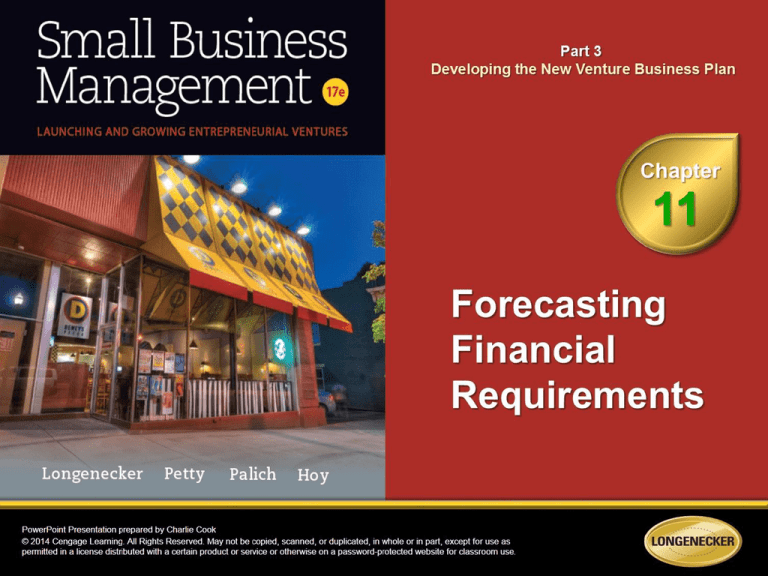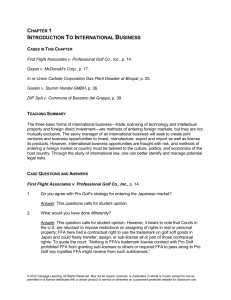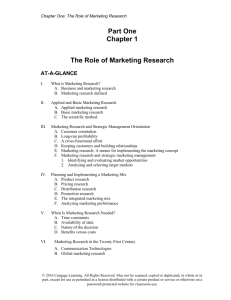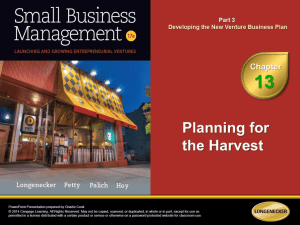
1. Describe the purpose for financial
forecasting.
2. Develop a pro forma income statement
to forecast a new venture’s profitability.
3. Determine a company’s asset and financing
requirements based on a pro forma balance
sheet.
4. Forecast a firm’s cash flows.
5. Provide some suggestions for effective
financial forecasting
© 2014 Cengage Learning. All Rights Reserved. May not be copied, scanned, or duplicated, in whole or in part, except for use as
permitted in a license distributed with a certain product or service or otherwise on a password-protected website for classroom use.
11–2
The Purpose of Financial Forecasting
• Pro Forma Financial Statements
Project a firm’s financial performance and condition
Purposes of pro forma statements:
1. How profitable is the firm be expected to be, given the
projected sales levels and the expected sales–expense
relationships?
2. How much and what type of financing (debt or equity) will be
needed to finance the firm’s assets?
3. Will the firm have adequate cash flows? If so, how will they be
used; if not, where will the additional cash come from?
© 2014 Cengage Learning. All Rights Reserved. May not be copied, scanned, or duplicated, in whole or in part, except for use as
permitted in a license distributed with a certain product or service or otherwise on a password-protected website for classroom use.
11–3
Forecasting Profitability
• Net Income Depends On:
Amount of sales
Cost of goods sold
Operating expenses
Interest expense
Taxes
“If we’re doing so well,
then why am I always
so broke?”
© 2014 Cengage Learning. All Rights Reserved. May not be copied, scanned, or duplicated, in whole or in part, except for use as
permitted in a license distributed with a certain product or service or otherwise on a password-protected website for classroom use.
11–4
11.1
Pro Forma Income
Statements for
D&R Products, Inc.
© 2014 Cengage Learning. All Rights Reserved. May not be copied, scanned, or duplicated, in whole or in part, except for use as
permitted in a license distributed with a certain product or service or otherwise on a password-protected website for classroom use.
11–5
Forecasting Asset and
Financing Requirements
• Working Capital
Current assets, accounts receivable, and inventory
required in day-to-day operations
• Net Working Capital
Current assets less current liabilities
• Bootstrapping
Minimizing a firm’s investments
© 2014 Cengage Learning. All Rights Reserved. May not be copied, scanned, or duplicated, in whole or in part, except for use as
permitted in a license distributed with a certain product or service or otherwise on a password-protected website for classroom use.
11–6
11.2
Assets-to-Sales Financing Relationships
© 2014 Cengage Learning. All Rights Reserved. May not be copied, scanned, or duplicated, in whole or in part, except for use as
permitted in a license distributed with a certain product or service or otherwise on a password-protected website for classroom use.
11–7
Forecasting Asset and
Financing Requirements (cont’d)
• Determining Asset Requirements
Industry ratios for assets-to-sales
Using an industry average of a “typical” firm’s assets to its
sales to forecast a particular firm’s asset requirements.
Percentage-of-sales technique
Using a percentage of the total sales for a firm as the basis
for forecasting the level of assets. accounts receivable, and
inventories to be held by a firm.
© 2014 Cengage Learning. All Rights Reserved. May not be copied, scanned, or duplicated, in whole or in part, except for use as
permitted in a license distributed with a certain product or service or otherwise on a password-protected website for classroom use.
11–8
Percentage-of-Sales Technique Example
© 2014 Cengage Learning. All Rights Reserved. May not be copied, scanned, or duplicated, in whole or in part, except for use as
permitted in a license distributed with a certain product or service or otherwise on a password-protected website for classroom use.
11–9
Determining Financing Requirements
• Basic Principles for Financing of Firms
1. The more assets a firm needs, the greater the firm’s
financial requirements.
2. A firm should finance its growth in such a way as to
maintain proper liquidity.
3. The amount of total debt used in financing a firm is
limited by the funds provided by the owners.
4. Some types of short-term debt maintain a relatively
constant relationship with sales.
5. Equity ownership comes the investments of owners,
and retained earnings (profits).
© 2014 Cengage Learning. All Rights Reserved. May not be copied, scanned, or duplicated, in whole or in part, except for use as
permitted in a license distributed with a certain product or service or otherwise on a password-protected website for classroom use.
11–10
Determining Financing Requirements
• Liquidity
The degree to which a firm has working capital
available to meet maturing debt obligations.
• Current Ratio
The firm’s relative liquidity, determined by dividing
current assets by current liabilities.
• Debt Ratio
Debt as a fraction of assets; total debt divided by total
assets.
Spontaneous financing—debts such as accounts payable that
increase as the firm grows.
© 2014 Cengage Learning. All Rights Reserved. May not be copied, scanned, or duplicated, in whole or in part, except for use as
permitted in a license distributed with a certain product or service or otherwise on a password-protected website for classroom use.
11–11
Sources of Equity Capital
• External Equity
The owners’ original investment
• Profit Retention
The reinvestment of profits in a firm
• Internal Equity
Capital from retaining profits within the firm
• Forecasting financial requirements (in total):
Total asset
=
requirements
Total sources
of financing
Spontaneous
=
financing
+
© 2014 Cengage Learning. All Rights Reserved. May not be copied, scanned, or duplicated, in whole or in part, except for use as
permitted in a license distributed with a certain product or service or otherwise on a password-protected website for classroom use.
Profits
retained
within
business
+
External
sources of
financing
11–12
Sources of Financing for D&R Products
Financial Ratio Estimates for D&R Products
© 2014 Cengage Learning. All Rights Reserved. May not be copied, scanned, or duplicated, in whole or in part, except for use as
permitted in a license distributed with a certain product or service or otherwise on a password-protected website for classroom use.
1–13
11.3
Pro Forma
Balance Sheets for
D&R Products, Inc.
© 2014 Cengage Learning. All Rights Reserved. May not be copied, scanned, or duplicated, in whole or in part, except for use as
permitted in a license distributed with a certain product or service or otherwise on a password-protected website for classroom use.
11–14
11.4
Pro Forma
Balance Sheets for
D&R Products, Inc.
© 2014 Cengage Learning. All Rights Reserved. May not be copied, scanned, or duplicated, in whole or in part, except for use as
permitted in a license distributed with a certain product or service or otherwise on a password-protected website for classroom use.
11–15
11.5
Pro Forma Cash Flow Statements for D&R Products, Inc.
© 2014 Cengage Learning. All Rights Reserved. May not be copied, scanned, or duplicated, in whole or in part, except for use as
permitted in a license distributed with a certain product or service or otherwise on a password-protected website for classroom use.
11–16
11.6
Three-Month Cash Budget for D&R Product, Inc.
*For example, January sales of $4,000 are collected as follows:
(40%) $1,600 in January,
(30%) $1,200 in February,
(30%) $1,200 in March.
© 2014 Cengage Learning. All Rights Reserved. May not be copied, scanned, or duplicated, in whole or in part, except for use as
permitted in a license distributed with a certain product or service or otherwise on a password-protected website for classroom use.
11–17
Use Good Judgment When Forecasting
• Practical Suggestions
1. Develop realistic sales projections.
2. Build projections from clear assumptions
3.
4.
5.
6.
7.
8.
about marketing and pricing plans.
Do not use unrealistic profit margins.
Don’t limit your projections to an income statement.
Provide monthly data for the upcoming year and
annual data for succeeding years.
Avoid providing too much financial information.
Be certain that the numbers reconcile—and not by
simply plugging in a figure.
Follow the plan.
© 2014 Cengage Learning. All Rights Reserved. May not be copied, scanned, or duplicated, in whole or in part, except for use as
permitted in a license distributed with a certain product or service or otherwise on a password-protected website for classroom use.
11–18
Key Terms
cash budget
line of credit
net working capital
pro forma financial statements
percentage-of-sales technique
spontaneous financing
© 2014 Cengage Learning. All Rights Reserved. May not be copied, scanned, or duplicated, in whole or in part, except for use as
permitted in a license distributed with a certain product or service or otherwise on a password-protected website for classroom use.
11–19












